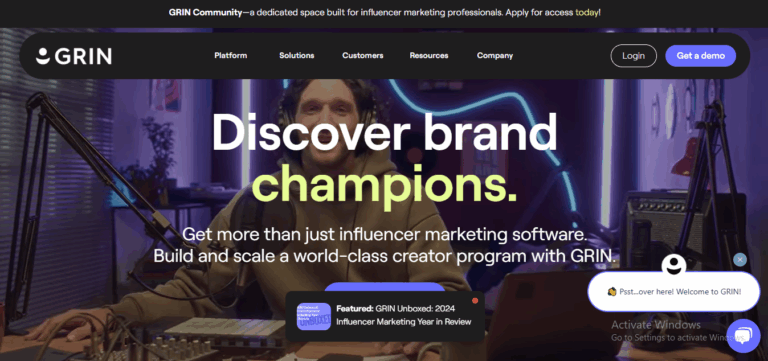So listen, I’ve used Grin and yeah, it’s great. If influencer marketing were high school, Grin would totally be the well-rounded overachiever with a full ride to Stanford. But like any good social circle, sometimes you wanna branch out—meet new people (or platforms), see different vibes, maybe find something that fits your brand better.
I’ve tested a bunch of these bad boys, so buckle up for a no-fluff, low-key fun breakdown of the best Grin alternatives you should actually be looking at in 2025.
1. Mavrck
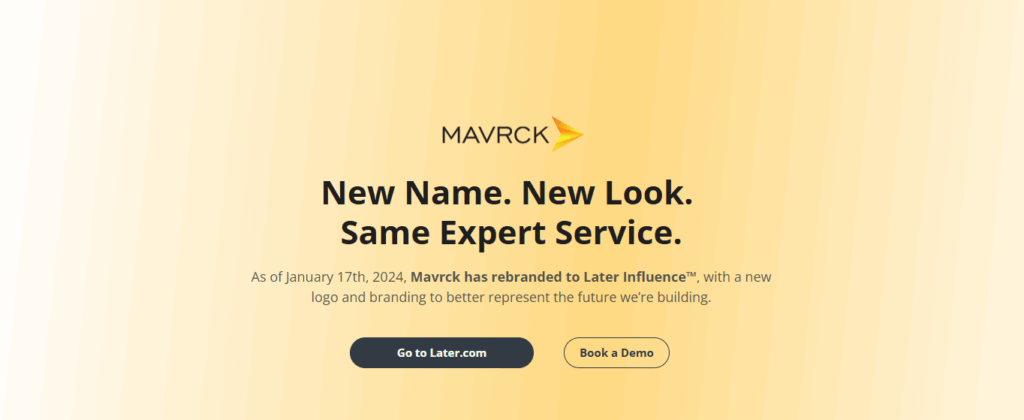
The Boss Level Platform — Big Brand Energy Only
What I Liked:
- Automation goals: campaign flows, product seeding, and payments all handled in-platform.
- Can manage entire ambassador programs + UGC + loyalty.
- Great for companies juggling multiple influencers at scale.
What I Didn’t:
- If you’re a small brand, this thing is overkill.
- UI is very “corporate dashboard”—not cute or intuitive at first.
Features:
- End-to-end influencer automation
- Content licensing and syndication
- Loyalty program integrations
Pricing:
Custom. And yeah, it’s steep. Think enterprise-level spenders with big influencer squads.
2. The Influence Room
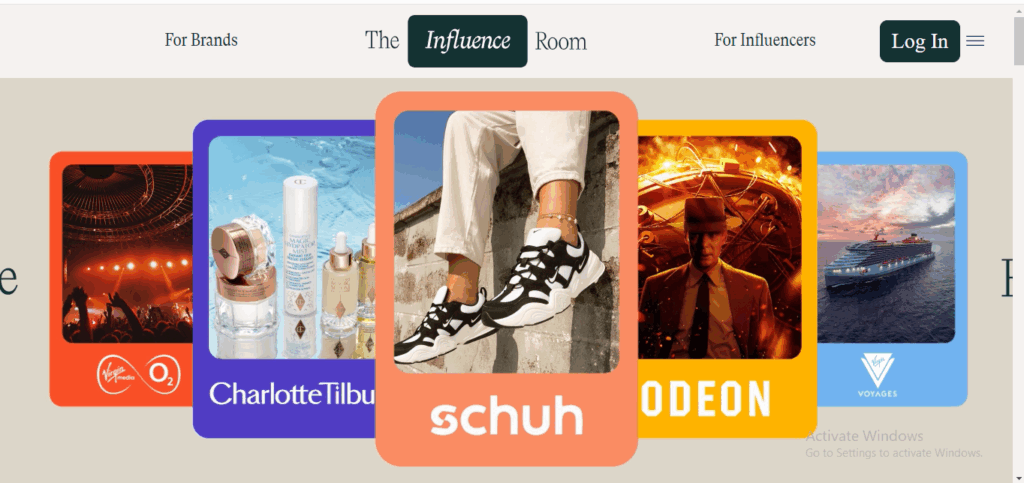
Where Influencers & Brands Actually Date Before They Get Married
What I Liked:
- Relationship-driven. You pitch your brand, and creators pitch themselves.
- No algorithmic matching—actual humans pick who they vibe with.
- Clean, minimal interface. Makes you feel fancy.
What I Didn’t:
- If you’re impatient, this ain’t it. Pitches take time to roll in.
- Works better for brands in fashion, beauty, lifestyle—less so for niche tech stuff.
Features:
- Collaborative marketplace
- Creator profiles with past collabs
- Brief-to-pitch model
Pricing:
Custom packages. Mid-high range but great value for long-term influencer collabs.
3. Influencity
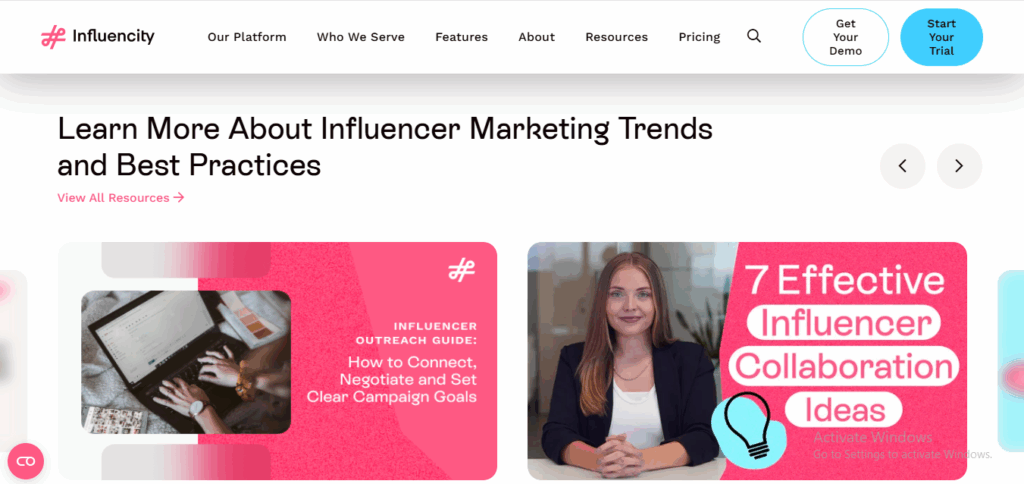
The Underrated Indie Flick of the Influencer World
What I Liked:
- AI-powered discovery is chef’s kiss. Tons of filters = super precise targeting.
- Pricing is actually sane. Small brands won’t cry.
- Reports are 🔥—detailed but digestible.
What I Didn’t:
- UI is solid, but a little “spreadsheet-y.”
- Smaller creator pool than Grin or Mavrck.
Features:
- Fake follower detection
- Audience & engagement deep dives
- Campaign management with analytics
Pricing:
Starts low and scales well. One of the best bang-for-buck tools on this list.
4. Hashtag Paid

The Cool Kid Who Only Works With People They Like
What I Liked:
- You get handpicked influencer matches (aka no more blind dates).
- You write a brief, and only creators who fit will pitch. No spammy requests.
- Great for content licensing and paid social integration.
What I Didn’t:
- Limited if you want full control over who to invite.
- More North America-centric.
Features:
- Creator marketplace with opt-in system
- Usage rights built in
- Messaging and contract management
Pricing:
Mid to high. You’re paying for curation and quality—worth it if you want less chaos.
5. Lolly
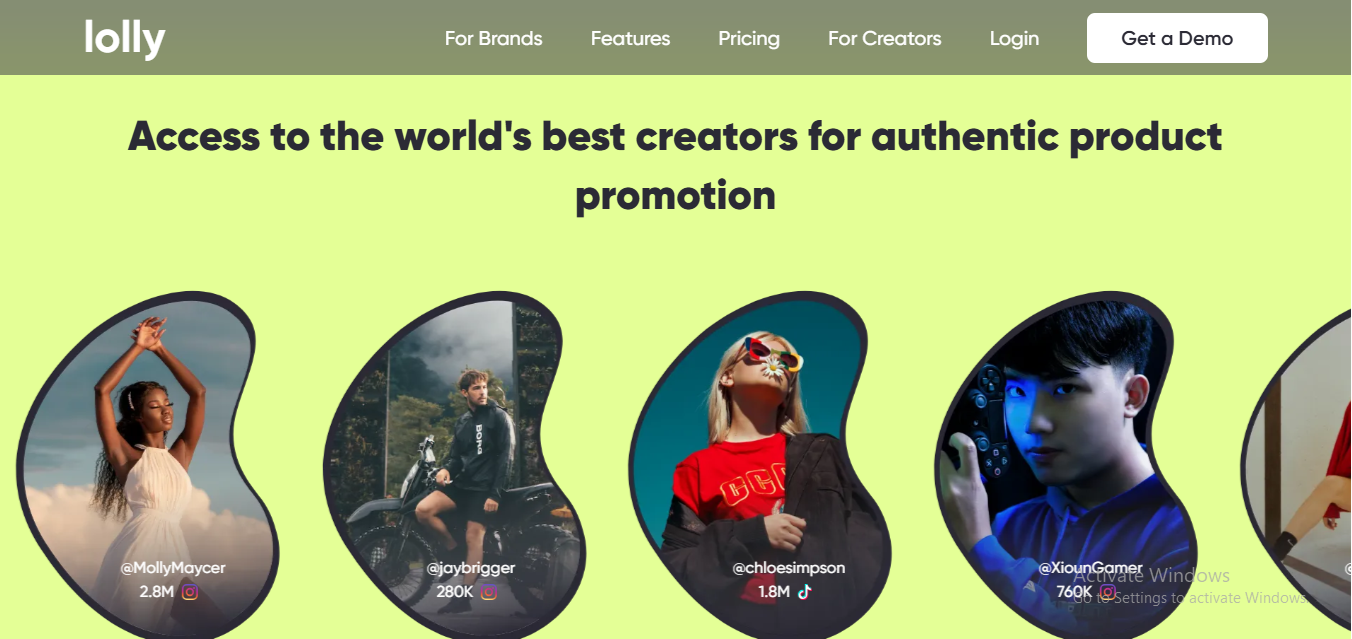
TikTok Energy in a Bottle (Well, a Platform)
What I Liked:
- UGC-first and TikTok-focused. If you want short-form, they’re your squad.
- Really fresh UI. It actually feels fun to use.
- Built for Gen Z creators—fast-moving, visual, and casual AF.
What I Didn’t:
- Still building out core campaign management features.
- Doesn’t work as well for long-term collabs or B2B niches.
Features:
- Video-first influencer discovery
- Trend analysis tools
- Creator campaign board
Pricing:
Affordable for what it does. Great entry point for brands looking to dip toes in Gen Z waters.
6. The Cirqle

This One’s Giving Fashion Week Meets Data Nerd
What I Liked:
- Stunning interface. Like, this thing has better design than my favorite shopping app.
- Combines influencer management with e-comm and ad performance data.
- Works well for global campaigns.
What I Didn’t:
- Style over substance in a few areas (some features need more depth).
- Not the best fit for scrappy startups—it wants your whole brand strategy.
Features:
- Data-backed influencer scoring
- Campaign performance + ad integration
- Global creator network
Pricing:
Mid to high tier. It’s worth it for fashion/luxury/lifestyle brands who want metrics and aesthetics.
7. Popular Pays

The Platform for Collabs That Don’t Feel Corporate
What I Liked:
- SO creator-friendly. The vibe is very “collab, not contract.”
- They’ve got a marketplace for brands and creators to match—like Bumble for influencer gigs.
- Real-time chat and feedback tools make everything smoother than your fave IG filter.
What I Didn’t:
- Not ideal for mega campaigns or multi-phase projects—more one-off collabs.
- The creator pool isn’t as deep for B2B or niche industries.
Features:
- Creative collaboration workflows
- Quick campaign launches
- Chat + approvals in one place
Pricing:
Mid-range, totally fair for the features. Small-to-medium brands will be comfy here.
Verdict:
Great for brands who want quick-turn UGC or test the influencer waters without a full platform marriage.
8. Collabstr
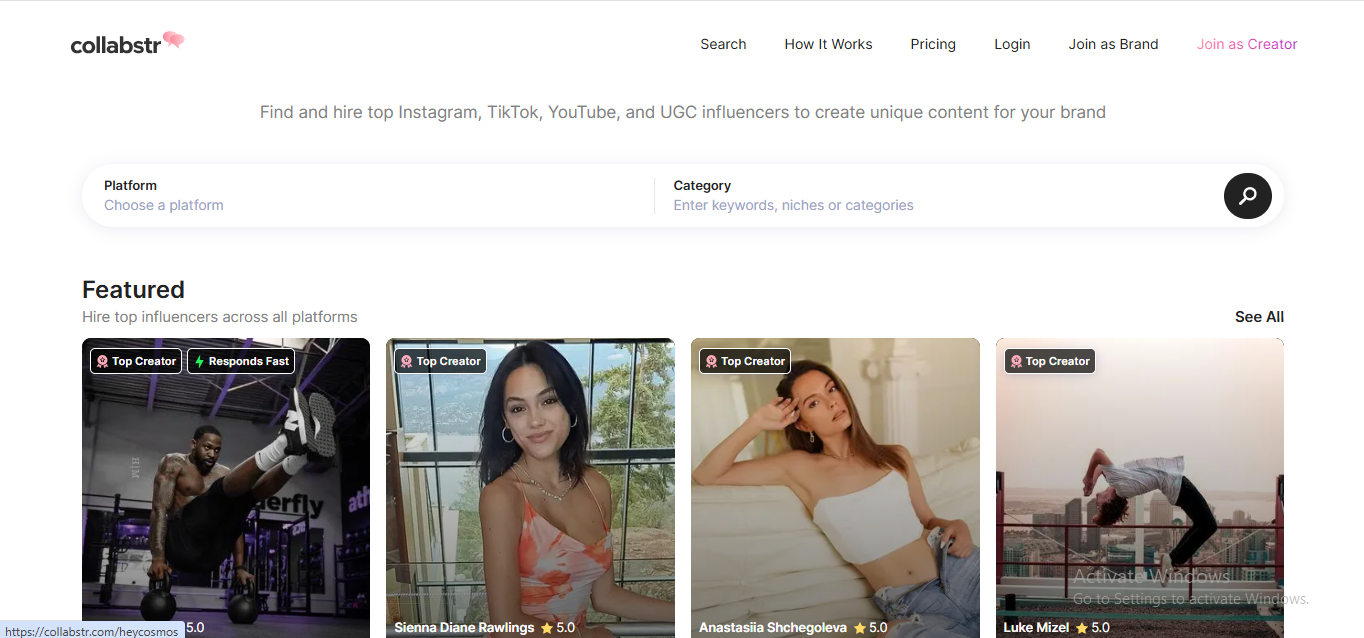
Influencer Marketplace That’s Fast AF (Like, Order-a-Creator Fast)
What I Liked:
- You can literally browse influencer profiles and book them like they’re on DoorDash.
- Transparent pricing. No back-and-forth. No “request a quote” nonsense.
- You get access to social proof, deliverables, and even follower breakdowns.
What I Didn’t:
- It’s transactional. Not a place to build long-term influencer relationships.
- Less support for deep campaign management or tracking ROI over time.
Features:
- Browse + book creators instantly
- Flat-rate pricing
- Creator storefronts with metrics
Pricing:
Pay-per-collab, so you’re only paying for what you use. No subscriptions. Love that.
Verdict:
Perfect if you’re just looking for one-off content or testing influencer marketing on a budget.
9. Kolsquare
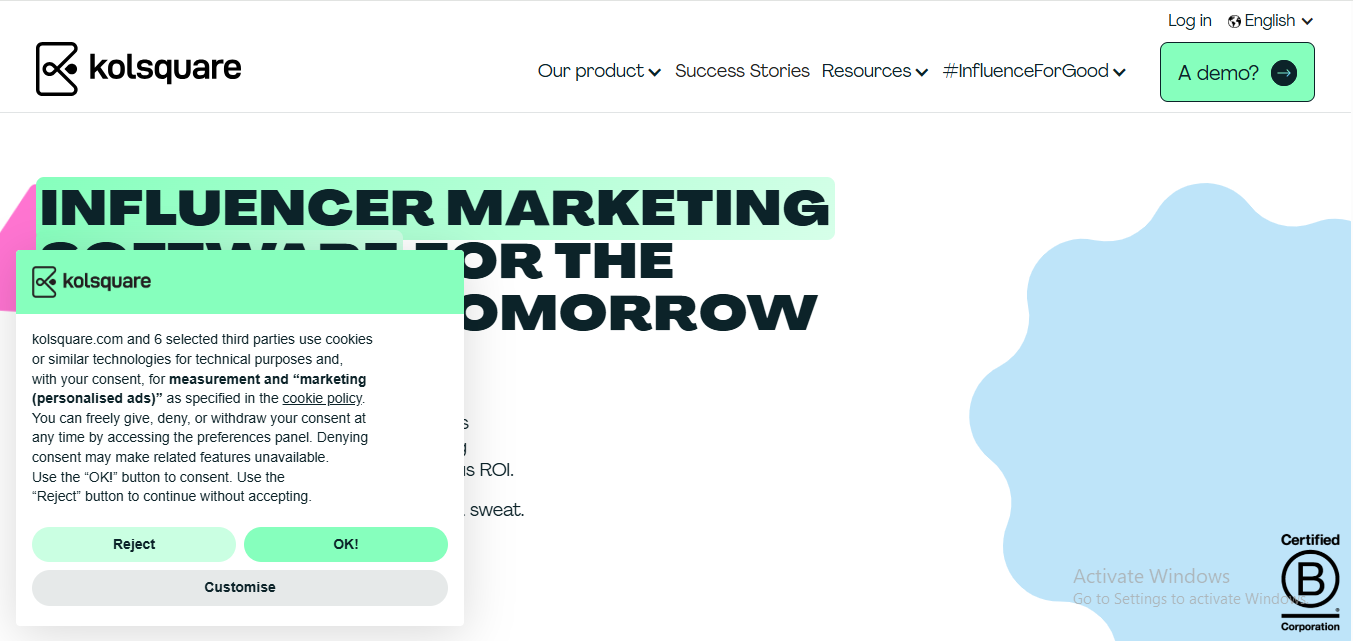
Big Brain Influencer Tech Meets Euro Vibes
What I Liked:
- SO data-driven. We’re talkin’ AI-powered influencer scoring, audience analysis, the works.
- Huge in Europe. Great for global brands wanting to get serious in EU markets.
- Very polished dashboard. It gives “enterprise chic.”
What I Didn’t:
- A little too stat-heavy for folks who just want to plug and play.
- Not cheap. Definitely made for companies ready to drop 💰.
Features:
- AI-powered influencer discovery
- Campaign management + analytics
- Advanced audience targeting (like, scary smart)
Pricing:
On the higher end, especially for the AI tools. But honestly? Worth it if you’re scaling hard.
Verdict:
Go here if you’re running tight, ROI-focused campaigns and love performance data.
10. Captiv8

The Beyoncé of Influencer Platforms—Polished, Powerful, Pricey
What I Liked:
- Enterprise-ready. This thing can run your entire influencer operation.
- Love the creator profiles with audience authenticity scores.
- Smart integrations with Shopify, Google, Meta—you name it.
What I Didn’t:
- There’s a learning curve. Not newbie-friendly.
- Definitely for teams, not solo marketers.
Features:
- Influencer CRM
- Real-time performance tracking
- Paid media + influencer ad amplification
Pricing:
Custom quotes only. If you have to ask, you might not be ready.
Verdict:
A beast of a platform. If your brand’s doing influencer marketing at scale, this is a top-tier pick.
11. Aspire (formerly AspireIQ)
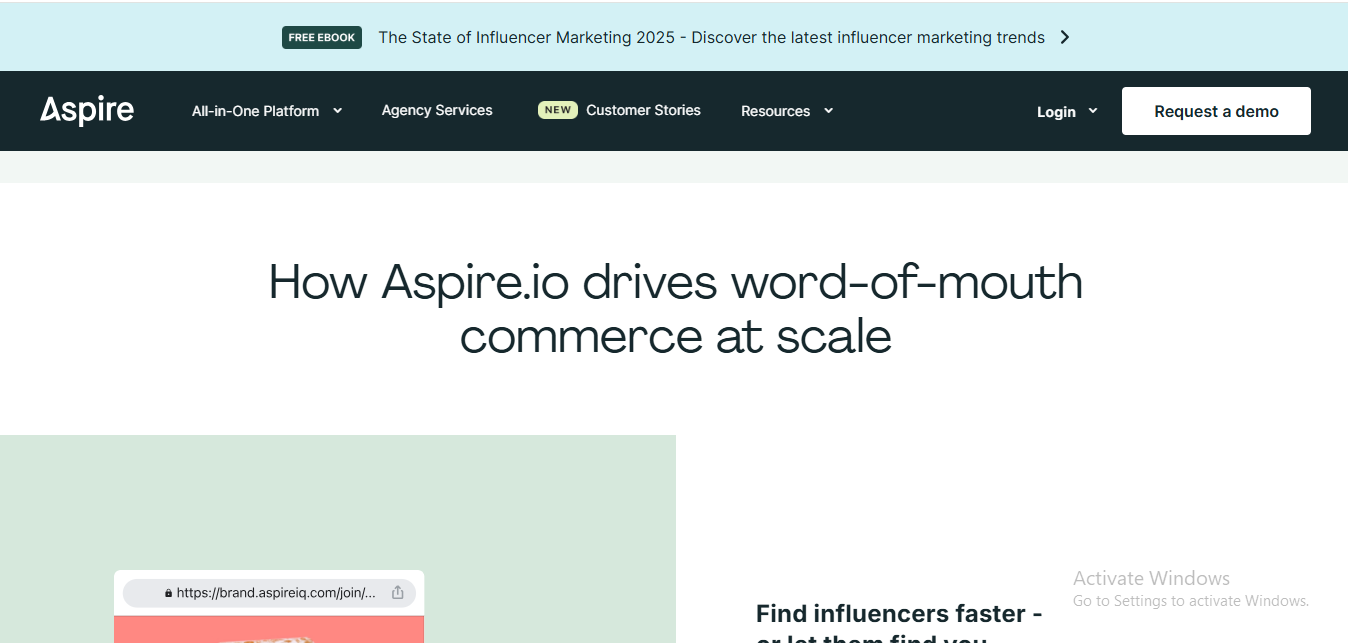
Like Tinder, But for Brands and Influencers That Actually Want a Relationship
What I Liked:
- Super smooth collab process: search, pitch, create, approve, all in one cozy space.
- Strong UGC tools and long-term partnership vibes.
- Tons of eComm love—integrates with Shopify and other tools brands actually use.
What I Didn’t:
- Discovery tools can feel limited unless you know what kind of creator you’re after.
- A little spendy for startups.
Features:
- Influencer search + outreach
- Product gifting + tracking
- Campaign management dashboard
Pricing:
Mid to high. Great value if you’re doing multiple campaigns a year.
Verdict:
Aspire is that platform you actually date, not just DM and ghost. Great for real brand-creator partnerships.
12. TRIBE
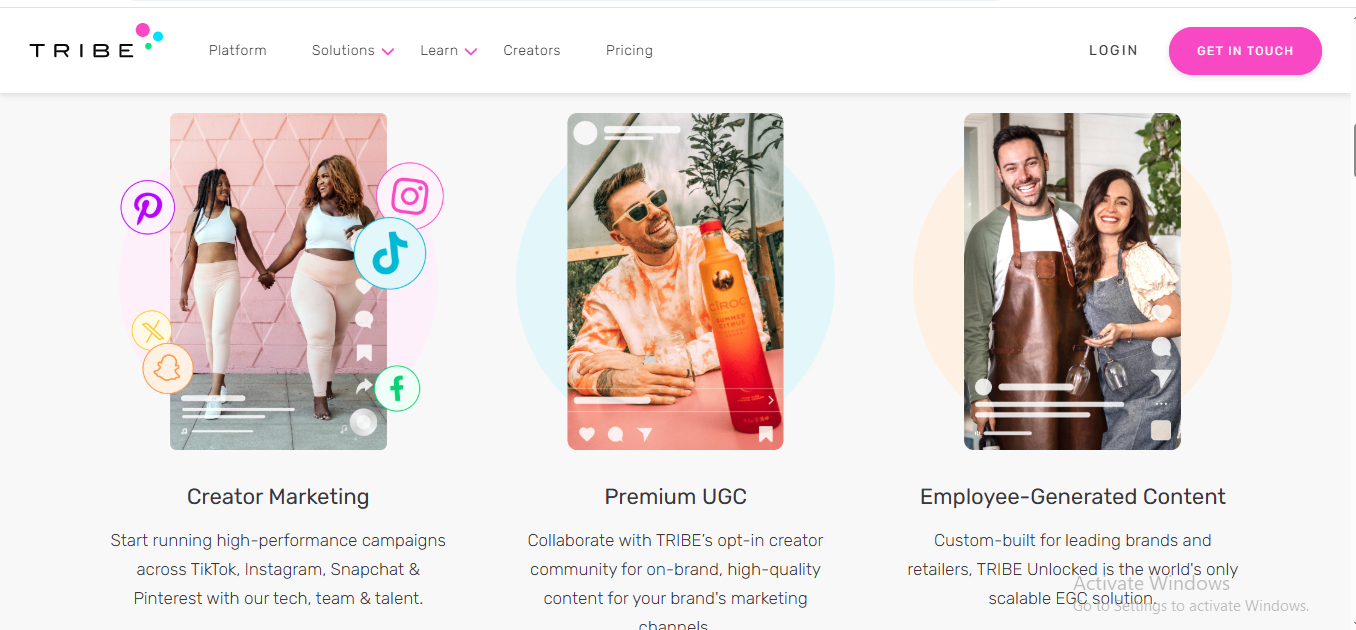
UGC-Obsessed & Proud of It
What I Liked:
- You post a brief, and creators pitch content. Like a creative casting call.
- It’s built for killer UGC—videos, stories, posts—without needing full influencer contracts.
- Fast, budget-friendly campaigns. You could have content tomorrow.
What I Didn’t:
- Not great for managing full-blown influencer campaigns.
- Pitches can vary in quality, so it takes time to sort the gems from the meh.
Features:
- Creator pitching system
- Usage rights baked in
- Paid ads integrations
Pricing:
Pay-per-content model. Start small, scale later. Easy on the wallet.
Verdict:
TRIBE is perfect if your brand’s content-hungry and doesn’t wanna deal with back-and-forth contracts.
13. Braze
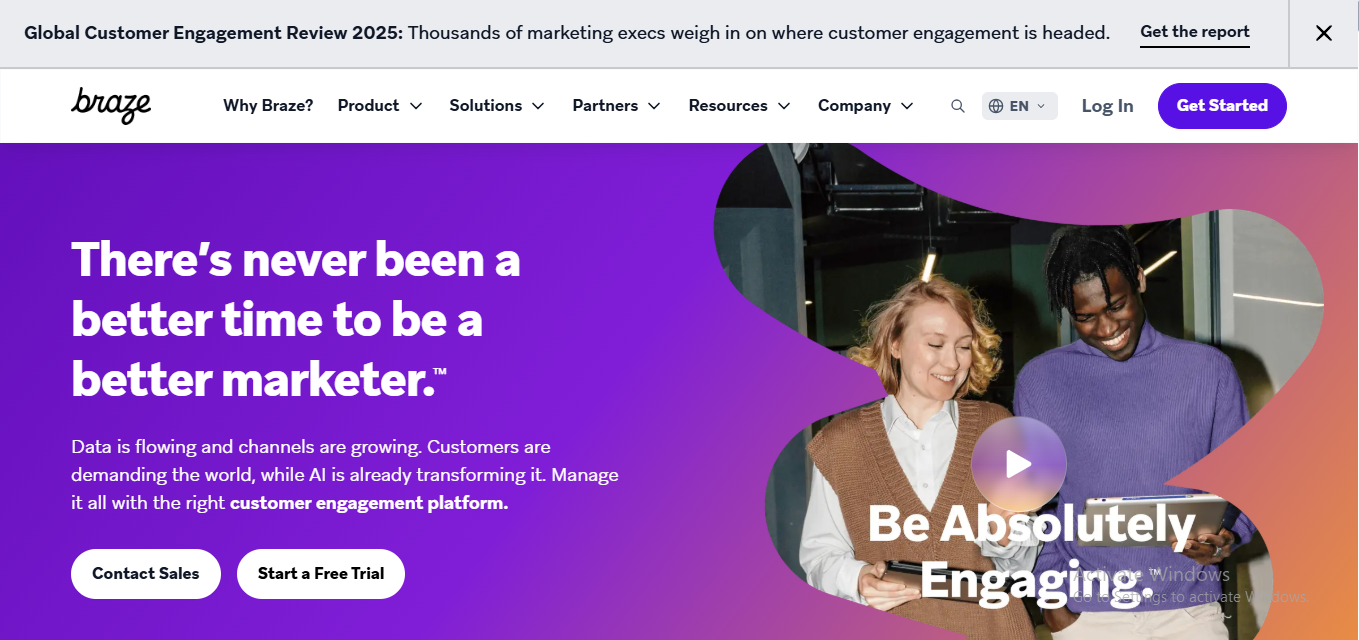
Ok, Not Technically an Influencer Platform—But It’s the Secret Weapon You Didn’t Know You Needed
What I Liked:
- Killer for audience engagement, especially post-campaign. Email, SMS, push—all the things.
- If you’re building a community or retention funnel after your influencer collab—this is it.
- Data layering makes targeting feel like a Netflix algorithm: creepily accurate.
What I Didn’t:
- Not for discovery or collab management—it’s more of a backend engagement platform.
- Can get super complex. Not plug-and-play.
Features:
- Multi-channel messaging
- Customer journey automation
- Real-time behavior-based targeting
Pricing:
Enterprise-level, but modular. Pay for what you need.
Verdict:
Pair this with any influencer platform above and boom—retention + community on lock.
14. IZEA
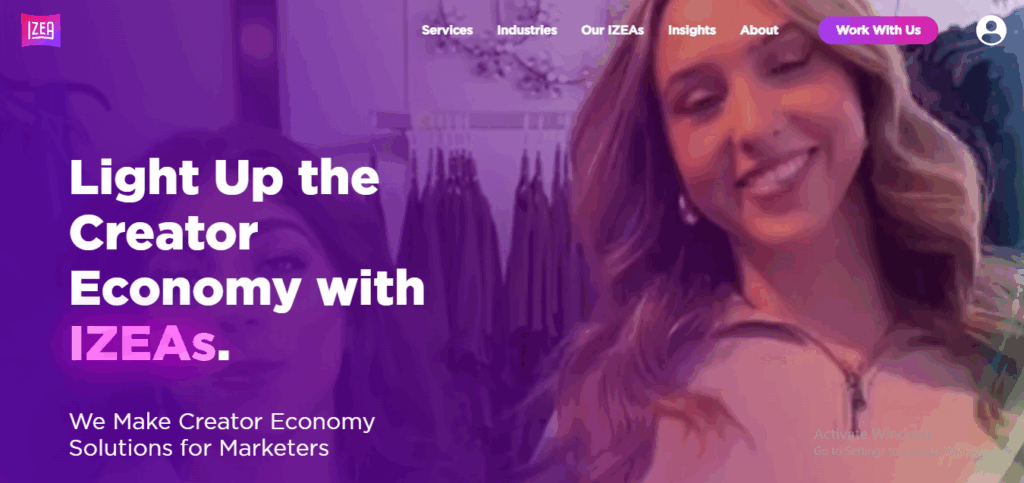
The O.G. of Influencer Platforms That’s Still Goin’ Strong
What I Liked:
- They’ve been around forever, and that shows in the polish.
- Marketplace is HUGE. You can find creators for everything—from TikTok dances to niche B2B blogs.
- Automated campaign tools make life soooo much easier.
What I Didn’t:
- The UX feels a little… 2018. It could use a refresh.
- Entry-level creators sometimes get buried in the crowd.
Features:
- Self-serve + managed services
- Payment processing (no Venmo drama!)
- Discovery + bidding marketplace
Pricing:
Subscription-based, with pricing tiers depending on how deep you go. Not dirt cheap, but fair for the size and scope.
Verdict:
A dependable all-rounder. If Grin was your ex, IZEA’s the mature rebound who won’t ghost you.
15. Insense
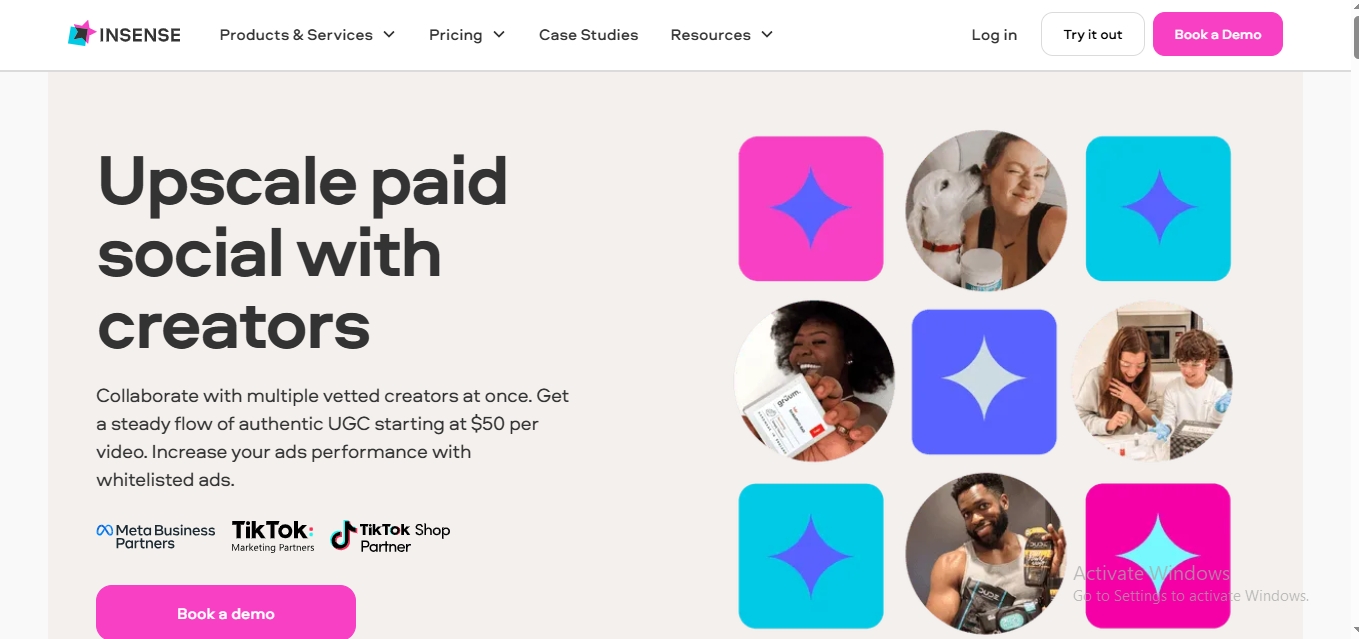
UGC Central for TikTok, Reels, and All That Short-Form Chaos
What I Liked:
- MASSIVE UGC focus. If you want creators to make content for you (not just post on their feed), this is your jam.
- Tons of built-in integrations with TikTok Ads, Meta, and Shopify.
- Creative briefs are easy to whip up and actually fun. No PhD in campaign planning required.
What I Didn’t:
- Doesn’t support super long-term influencer relationship building.
- Campaign metrics are there, but don’t expect NASA-level data.
Features:
- UGC creator marketplace
- Ad-ready content exports
- Shopify integration for product seeding
Pricing:
You pay per creator/campaign, which is amazing if you’re testing content strategies without diving head-first into subscriptions.
Verdict:
For TikTok content at scale without losing sleep (or your budget), Insense is a major vibe.
16. influence.co
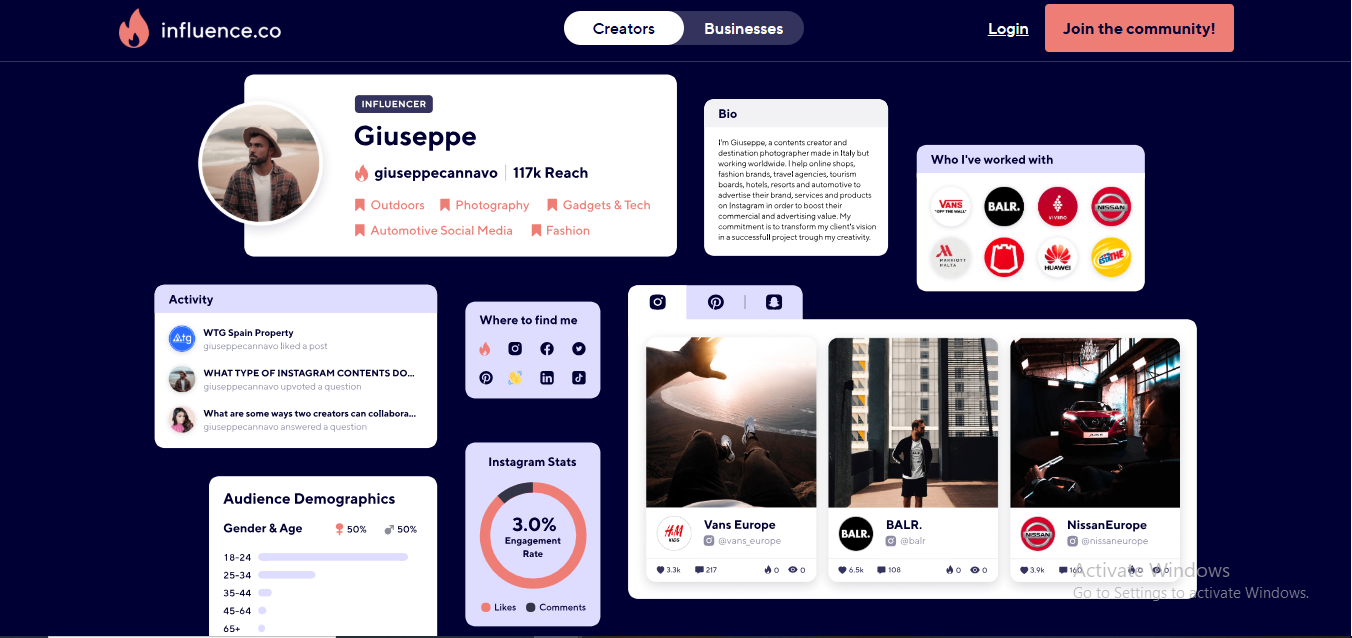
Where LinkedIn Meets the Influencer World
What I Liked:
- It’s more than a marketplace—it’s like a social network for influencers.
- You can see their vibe, their posts, their past campaigns—like, really stalk their creds (in a good way).
- There’s also a whole B2B side for managing collabs and running campaigns.
What I Didn’t:
- Some profiles felt like ghost towns. Gotta dig a bit for active talent.
- Not as automation-heavy as others—more DIY.
Features:
- Influencer portfolios + social profiles
- Campaign hub for discovery and messaging
- Community tools for building relationships
Pricing:
You can get started free, then pay for premium features and upgrades. Great starter choice.
Verdict:
Awesome for building long-term relationships and vetting talent like a boss. Perfect if you want to get to know your creators before diving in.
17. Influencer.com
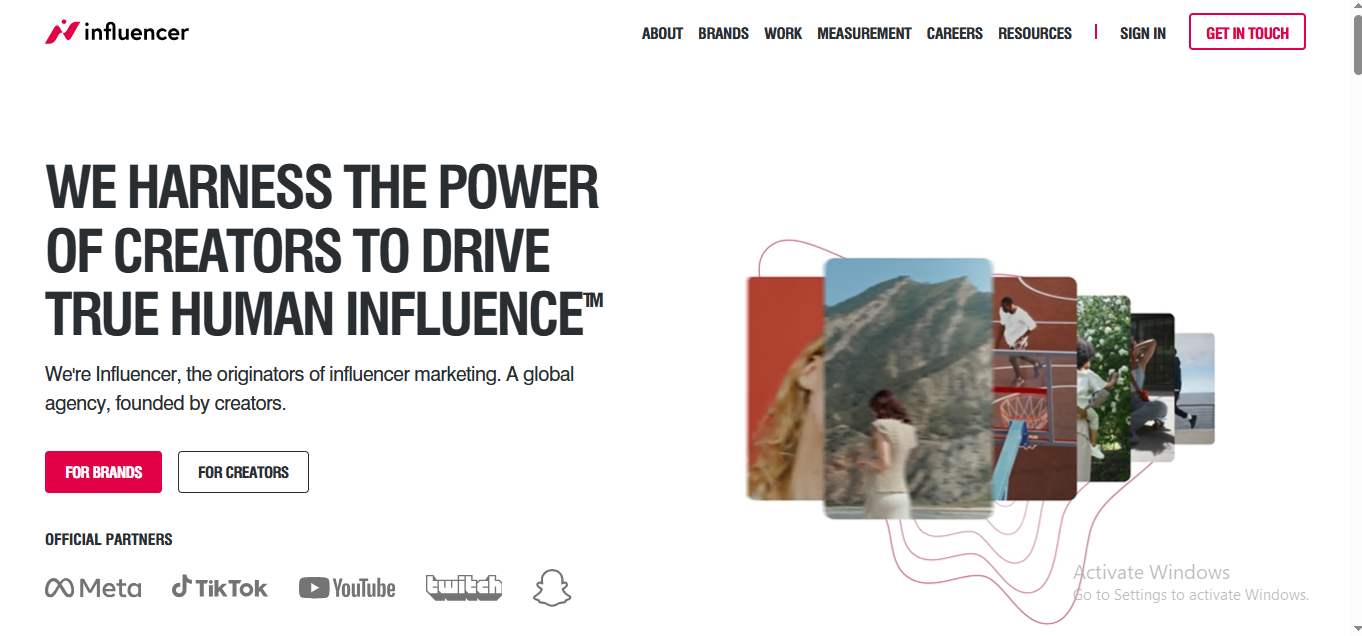
The James Bond of Platforms—Sleek, Sophisticated, and Kinda Fancy
What I Liked:
- Major enterprise vibes. The dashboard’s super polished and sexy.
- Full-funnel campaign management, from outreach to ROI tracking.
- AI-backed tools make influencer matching scarily accurate.
What I Didn’t:
- It’s not built for beginners. If you’re brand new, this might feel overwhelming.
- Big-budget energy. Like, bring the company card.
Features:
- End-to-end influencer marketing suite
- Audience and sentiment analysis
- Paid social amplification
Pricing:
Custom pricing for brands + agencies. Not cheap, but worth it if you need white-glove service.
Verdict:
For serious brands with serious goals. If you’re managing campaigns like a Marvel franchise—this one’s for you.
18. Later (formerly Later.com)
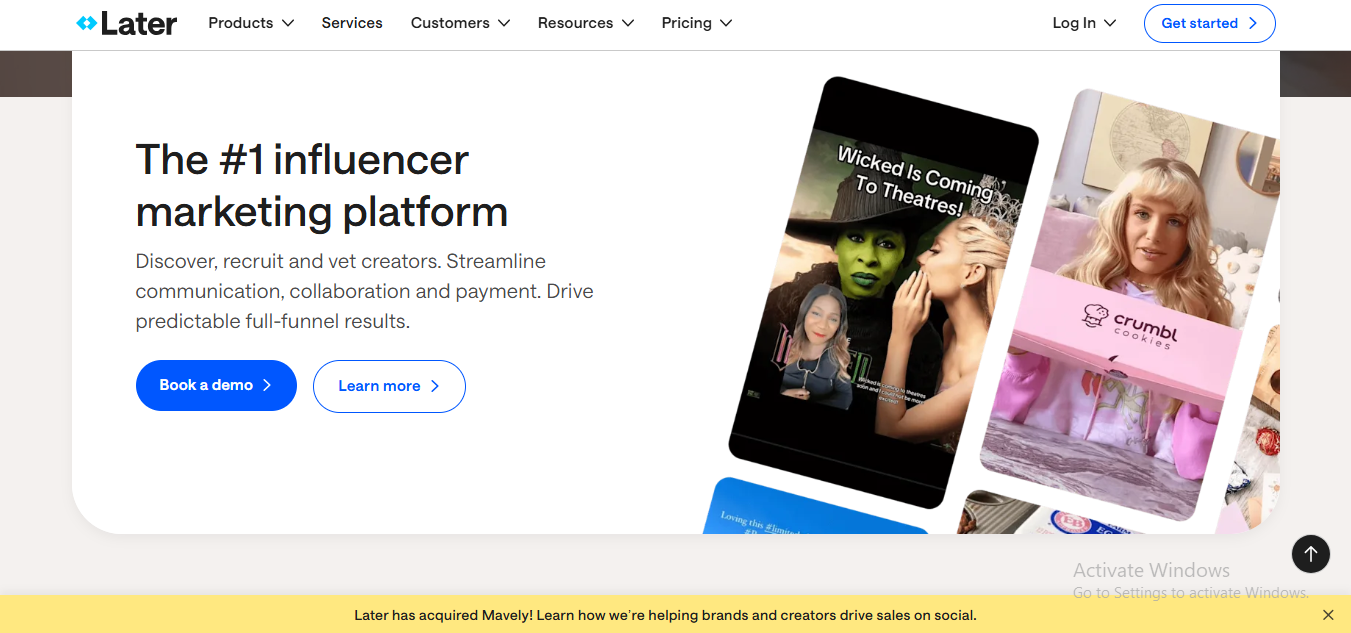
Not Just a Scheduler—It’s Your IG BFF
What I Liked:
- Their influencer tools are integrated into Later’s content scheduling platform.
- LOVE the visual calendar. It makes mapping campaigns stupidly simple.
- You can find creators, manage UGC, and then schedule it all without switching tabs.
What I Didn’t:
- More social-scheduling heavy than influencer-heavy.
- Not ideal for complex campaigns or long-term contracts.
Features:
- Visual content planner
- Creator + UGC tools
- Performance analytics for IG + TikTok
Pricing:
Affordable. They’ve got plans for small businesses all the way to agencies. Pretty reasonable.
Verdict:
Great for brands already living inside Instagram. If Reels, IG Stories, and carousels are your playground, Later’s a total gem.
19. Shout Agency
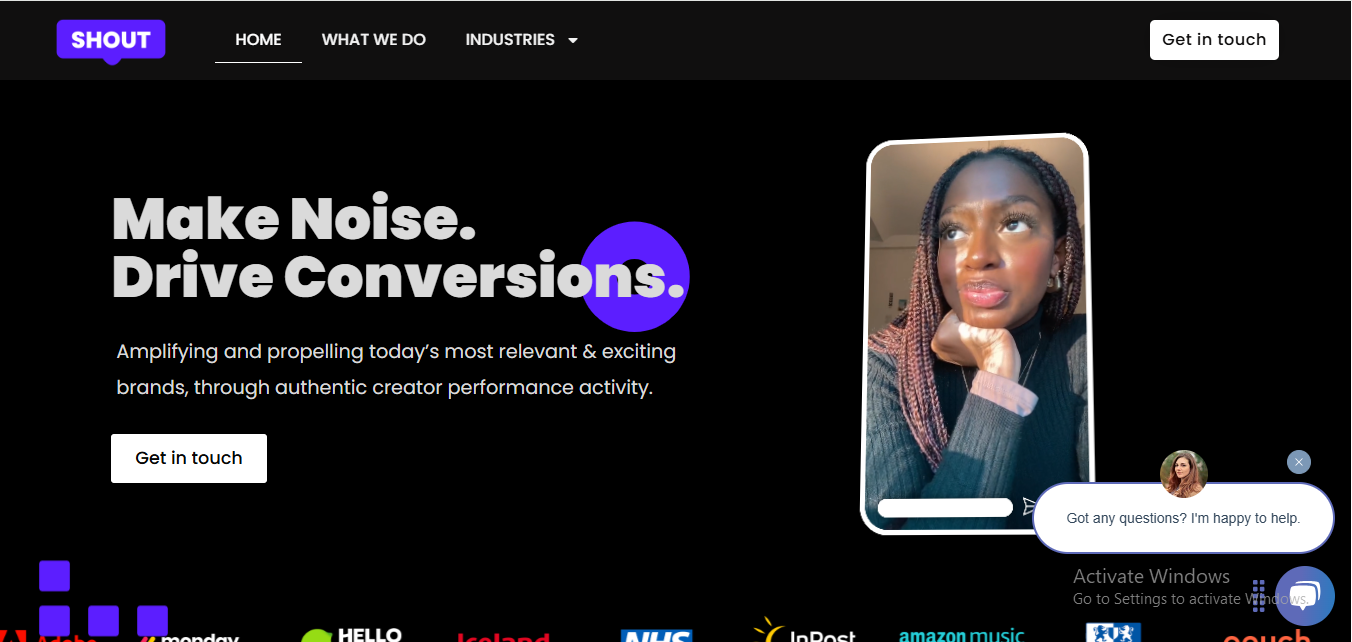
Full-Service Vibes Without the Agency Headache
What I Liked:
- They actually help you run the whole thing—strategy, creator outreach, content, all of it.
- Super transparent team. You get an account manager who gets your brand voice.
- Great reporting tools too. Clean, clear, and drama-free.
What I Didn’t:
- Not self-serve. So if you’re a DIY-er, this might not vibe with you.
- Limited platform if you just want the tech—this is more service-heavy.
Features:
- Influencer campaign management
- Strategy + creative planning
- Paid ad integration
Pricing:
Custom quotes, but competitive for full-service. No fluff, no nonsense.
Verdict:
Think of them like the cool boutique agency that actually delivers. Perfect if you’re tired of trying to do it all yourself.
20. Klear
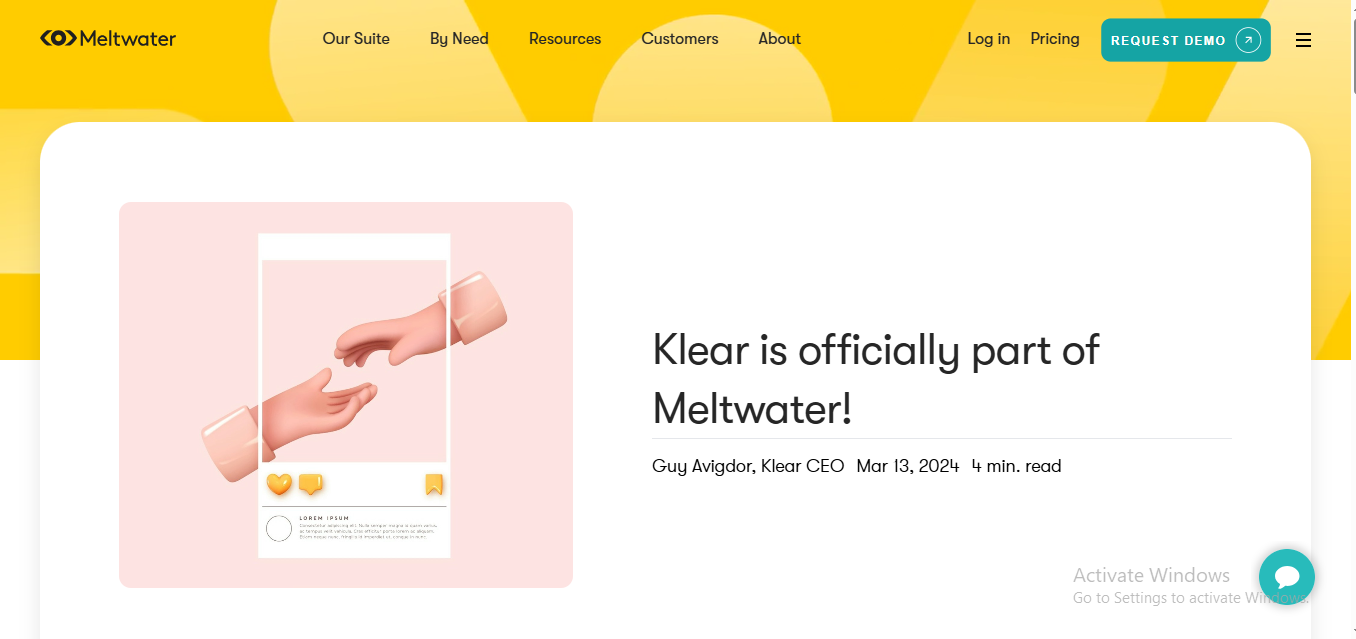
The Data Nerd’s Dream That’s Still Pretty to Look At
What I Liked:
- Influencer analytics? NEXT. LEVEL.
- You get breakdowns by psychographics, fake follower detection, audience interests, and more.
- CRM tool is fab. You can manage creator relationships like a pro.
What I Didn’t:
- Learning curve if you’re not used to super-detailed dashboards.
- Less about UGC creation, more about influencer tracking and ROI.
Features:
- Influencer discovery + vetting
- Relationship management
- Detailed analytics + performance tools
Pricing:
High-end. You’re paying for top-tier data, and it shows.
Verdict:
Ideal for brands who’ve been burned by fake followers and want the real deal. If you love receipts and results, Klear’s your go-to.
21. Brandbassador

The One That’s Made for the Hype-Beast Crowd
Yo, Brandbassador felt like the Gen Z cousin of influencer platforms. Super slick UI and full of gamified missions that make influencers want to participate. Think: turning your fans into brand reps—kinda like turning your hype squad into your sales team.
What I Liked:
- Gamification is genius. Missions, rewards, tier systems… it’s fun.
- Handles nano to macro influencers.
- You can manage the whole campaign lifecycle in one place—yes, from recruiting to paying out cash or store credit.
What I Didn’t:
- Pricing is up there for small brands.
- Bit of a learning curve on setup.
Pricing: Custom, but not exactly wallet-friendly for tiny teams.
Verdict: Great for e-com brands with a young, engaged audience. If you’ve got an army of fans, this is where you turn them into ride-or-die reps.
22. Shout (ShoutUGC)
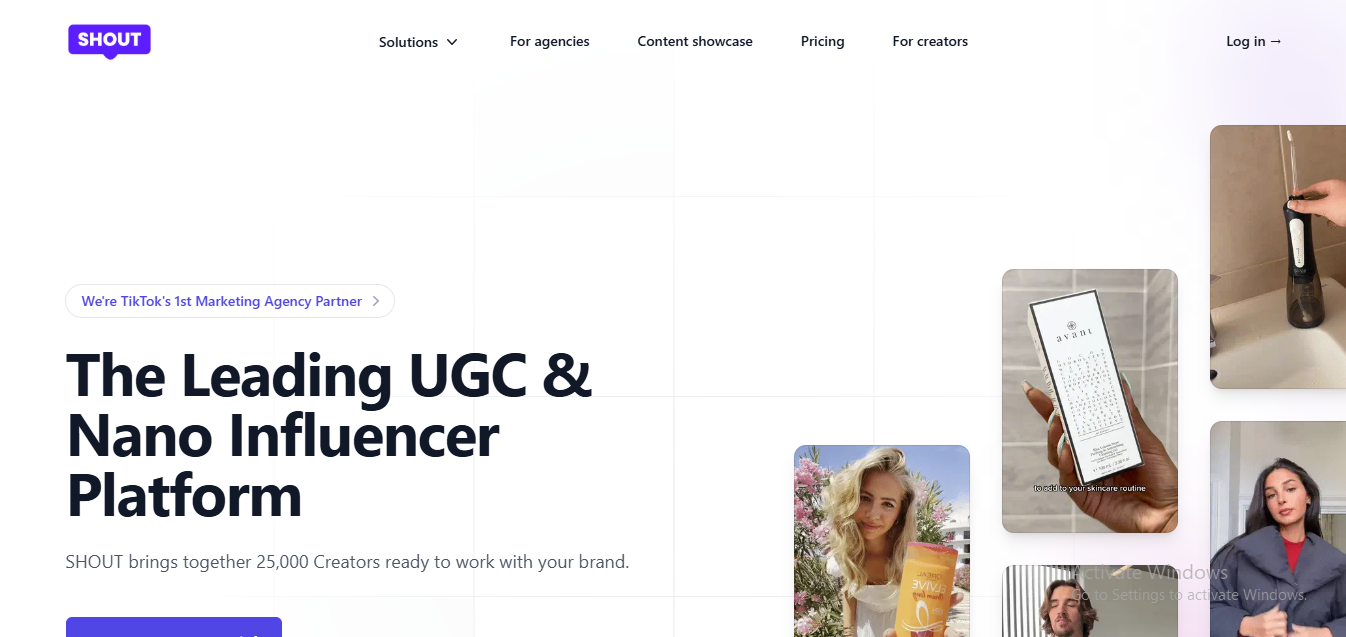
The TikTok of Influencer Platforms
Okay, if you love short-form, raw user-generated content, Shout is like finding a secret menu item. It’s all about turning regular people into content creators for your brand. UGC is hot rn, and Shout is capitalizing on it hard.
What I Liked:
- So easy to source authentic video content.
- No fluff. It’s built for quick, high-volume content generation.
- Campaigns are super simple to launch.
What I Didn’t:
- Less about long-term influencer collabs.
- No deep analytics—felt a lil’ surface-level.
Pricing: Pay-per-video model, which I actually loved for budget control.
Verdict: If you just want high-quality video content without sliding into 100 DMs, Shout is a hidden gem.
23. CreatorIQ
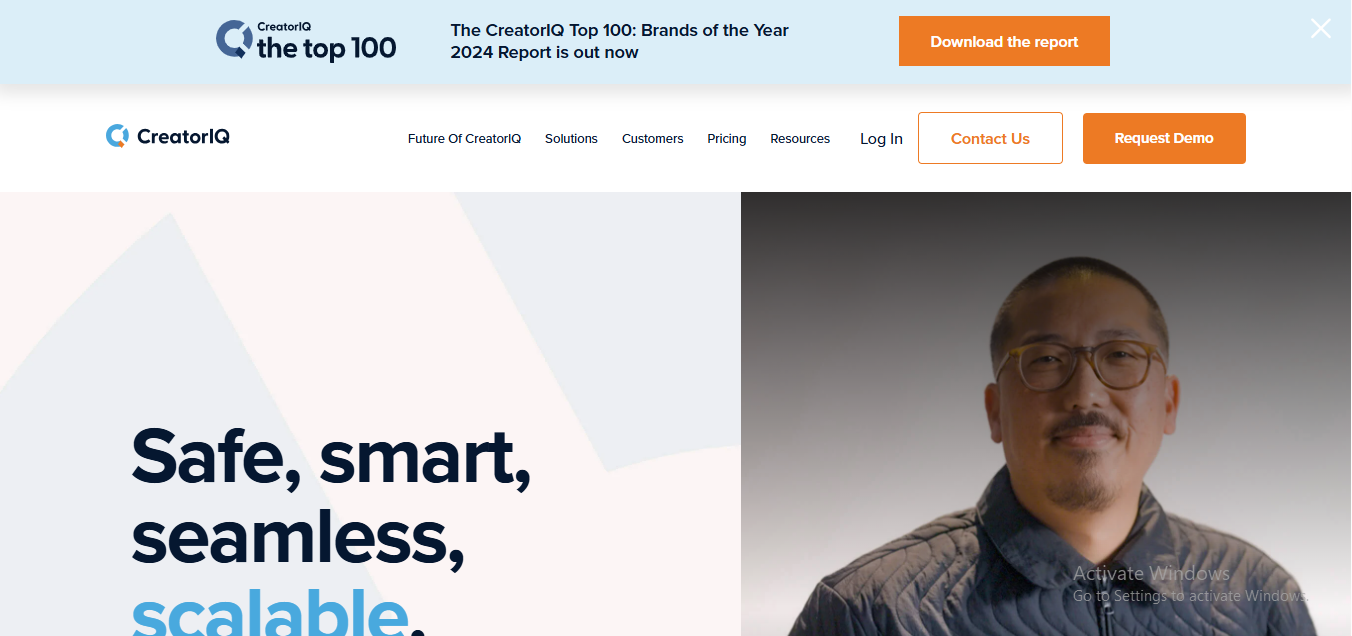
The Rolls-Royce of Influencer Platforms
Look, CreatorIQ is a beast. This is what the big boys use—think Fortune 500 energy. It’s data-heavy, super professional, and honestly made me feel like I needed a data scientist on speed dial.
What I Liked:
- Massive influencer database. Like… global domination level.
- Verified profiles only (bye, fake followers 👋).
- Integrates with everything (Google, TikTok, Insta, Salesforce—you name it).
What I Didn’t:
- Very enterprise-y. Small brands might feel overwhelmed.
- You’ll need onboarding, for sure.
Pricing: Premium AF. Think mid to high five figures per year.
Verdict: Not for the faint of heart, but if you’re a big brand with a serious budget—this is your power play.
24. InfluencerMarketing.ai
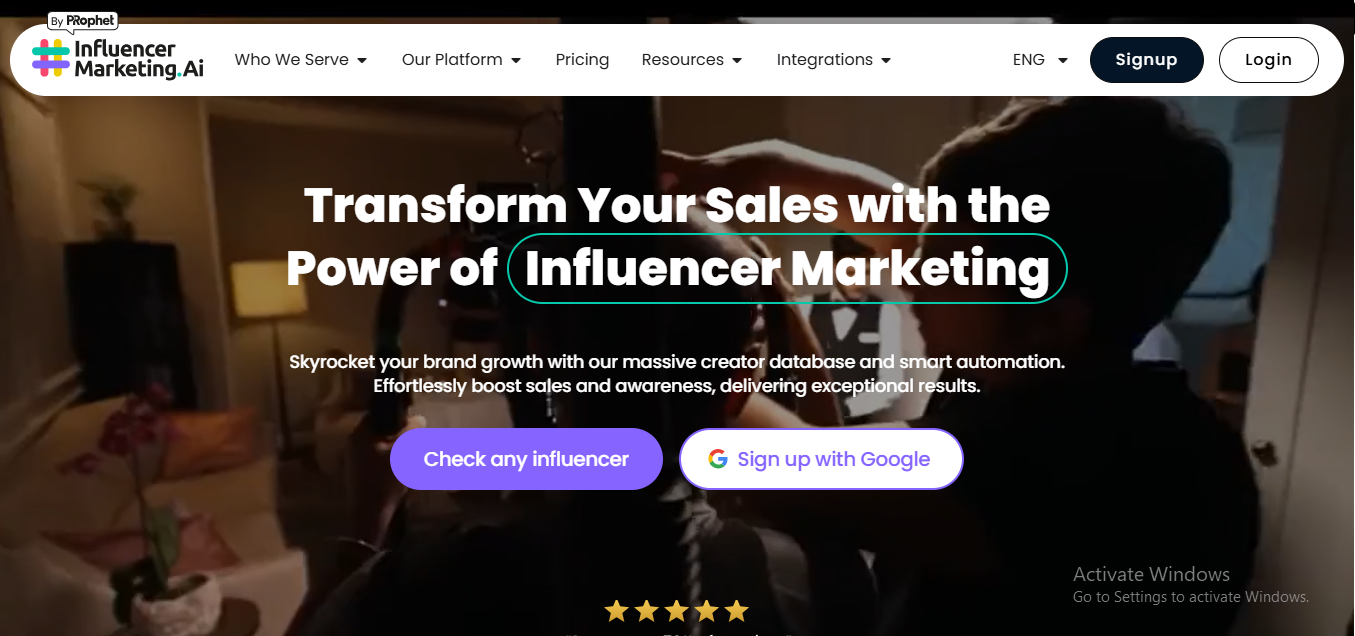
The AI Nerd’s Dream Platform
This one kinda surprised me. AI everywhere—matching, scoring, predictions. It’s like ChatGPT got hired to manage your influencer campaigns.
What I Liked:
- AI influencer discovery = fire. Way faster than scrolling IG for hours.
- Real-time performance tracking.
- AI-written content suggestions (we love a lazy genius).
What I Didn’t:
- Some matches felt a bit off—AI still learning, ya know?
- The UX wasn’t super polished.
Pricing: Mid-tier, good value for features.
Verdict: If you love automation and AI magic, this one will keep you geeked.
25. Traackr
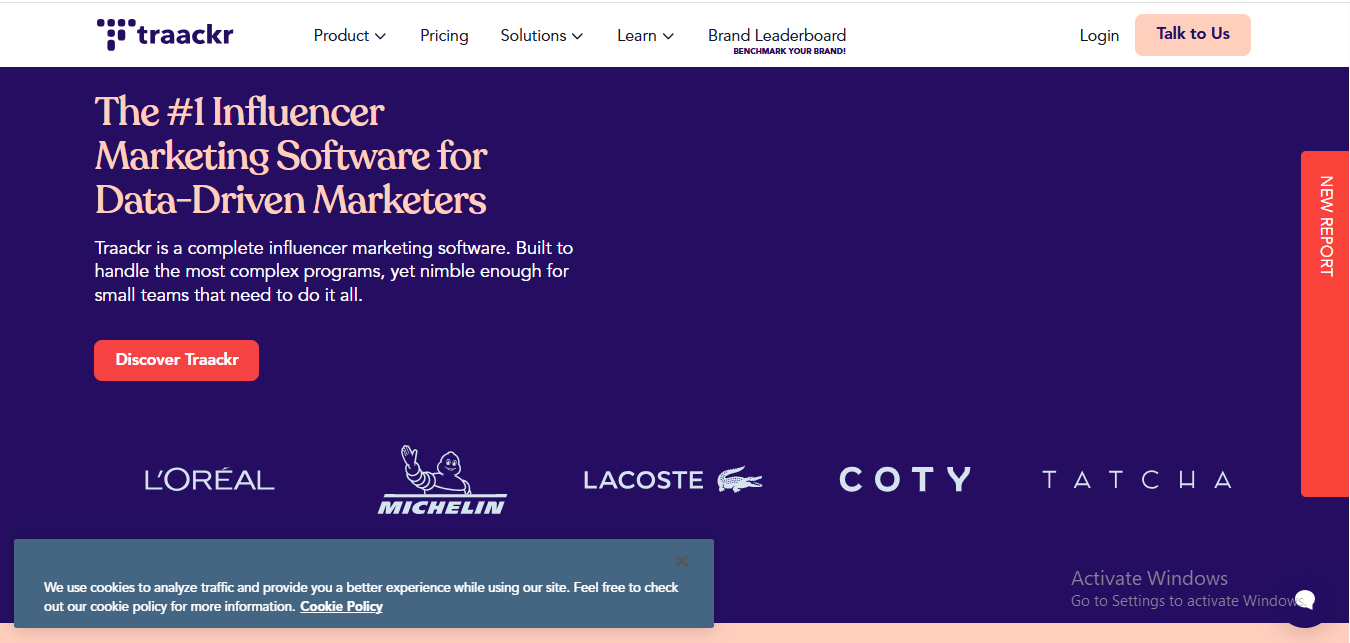
The Data-Obsessed One
Traackr is for marketers who treat campaigns like lab experiments. It’s all about influence analytics and ROI breakdowns. Less glam, more graphs.
What I Liked:
- Transparent spend tracking.
- Easy to compare influencers across niches and platforms.
- No shady numbers—they show actual impact.
What I Didn’t:
- Not super creative-campaign-friendly.
- More useful for brands already running mature influencer strategies.
Pricing: Definitely on the higher side.
Verdict: If you’re in deep and want to measure every single dollar, Traackr will feed your inner analytics nerd.
26. Upfluence
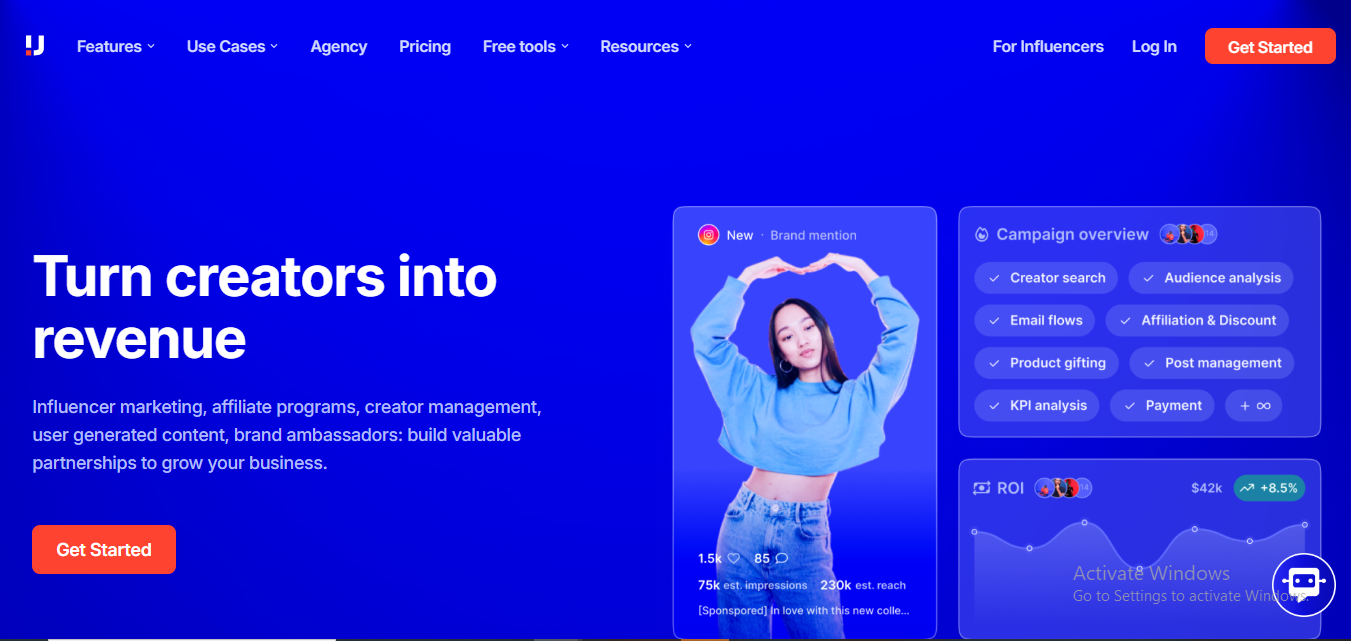
The Shopify-Approved Hustler
This one’s hella popular with eCommerce folks, and for good reason. You can integrate with your store, scan your own customers for potential influencers (wild), and launch campaigns from one dashboard.
What I Liked:
- Shopify + WooCommerce integrations = gold.
- Influencer search tool is 🔥—filters for days.
- Built-in email outreach (goodbye manual DMs).
What I Didn’t:
- Clunky UX in places.
- Support could be quicker.
Pricing: Mid-range. Subscription model based on features.
Verdict: If you’re a DTC brand ready to scale, this is a strong all-in-one platform.
27. Grin
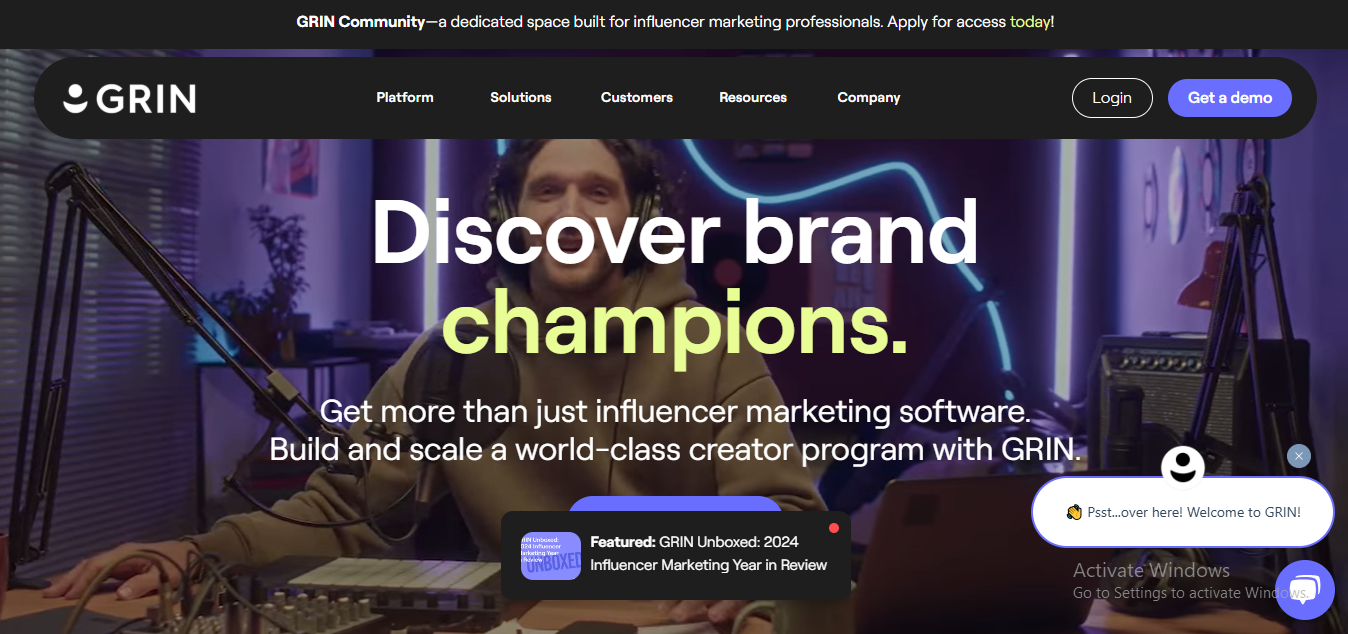
The One We’re Replacing—But Let’s Give Credit Where It’s Due
Before I drag it, lemme give props. Grin does a lot: influencer discovery, email comms, product seeding, payments—it’s like your full-stack influencer CRM. But it can also feel like you’re driving a spaceship just to go get groceries.
What I Liked:
- Super tight integrations (Shopify, Gmail, etc.)
- Influencer email outreach is smooth AF
- Product gifting workflows = chef’s kiss
What I Didn’t:
- Big learning curve (like, why so many buttons tho?)
- Expensive for small brands—this ain’t no side-hustle-friendly tool
- Discovery could be more intuitive
Pricing: Custom pricing, but think $$$—mostly aimed at mid to large brands.
Verdict: Grin’s a power tool, no doubt. But if you’re not playing in the big leagues yet, it might feel like overkill.
28. Meltwater
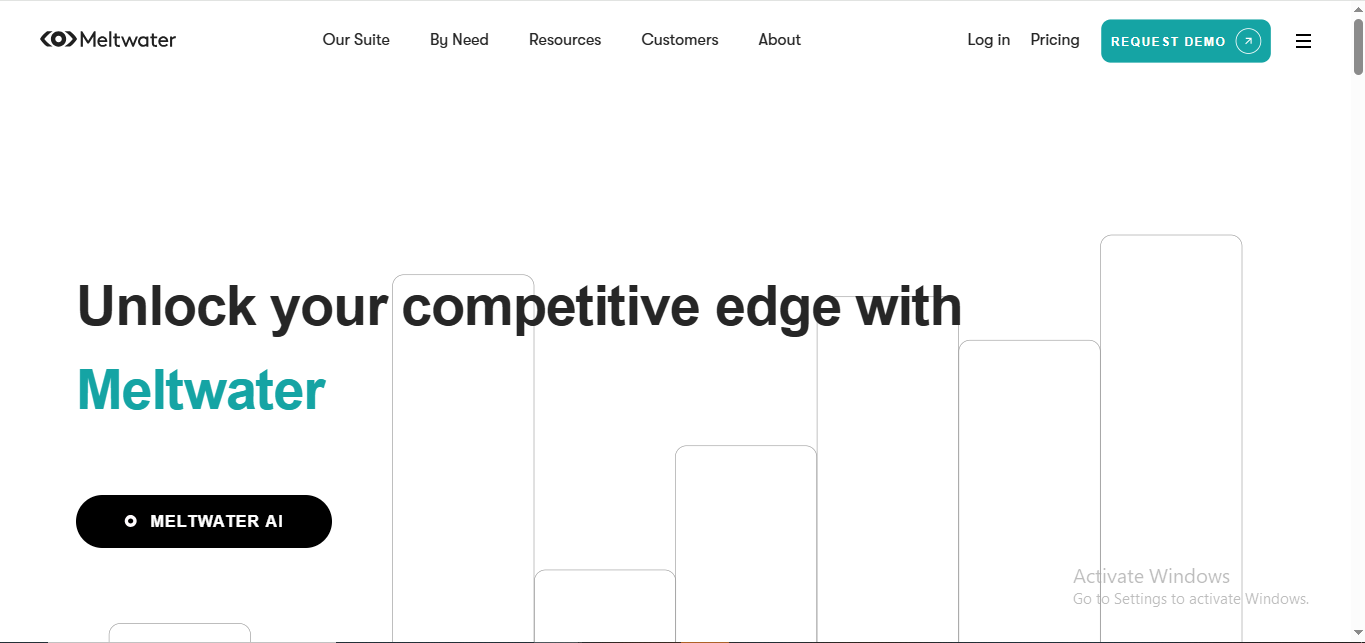
The Corporate Overachiever That Does Influencer on the Side
Okay, Meltwater isn’t just an influencer platform. It’s more like your brand’s all-seeing eye—PR, media monitoring, social listening, and yep, influencer campaign tools baked in. If you’re tryna keep your finger on the pulse of the entire internet, this one’s got you.
What I Liked:
- Ridiculously deep media tracking
- Strong influencer tracking baked into your larger comms strategy
- Great for global brands—seriously, it speaks like 40+ languages
What I Didn’t:
- Influencer stuff isn’t the main course—feels secondary
- UI is a bit… dated? Like, ‘early-2010s enterprise software’ vibes
- Can get pricey real fast
Pricing: Custom. Think enterprise-level—your social intern ain’t affording this.
Verdict: Use this if you’re a PR pro who moonlights in influencer marketing. Otherwise, it might be too much tech for too little influencer juice.
29. The Social Cat
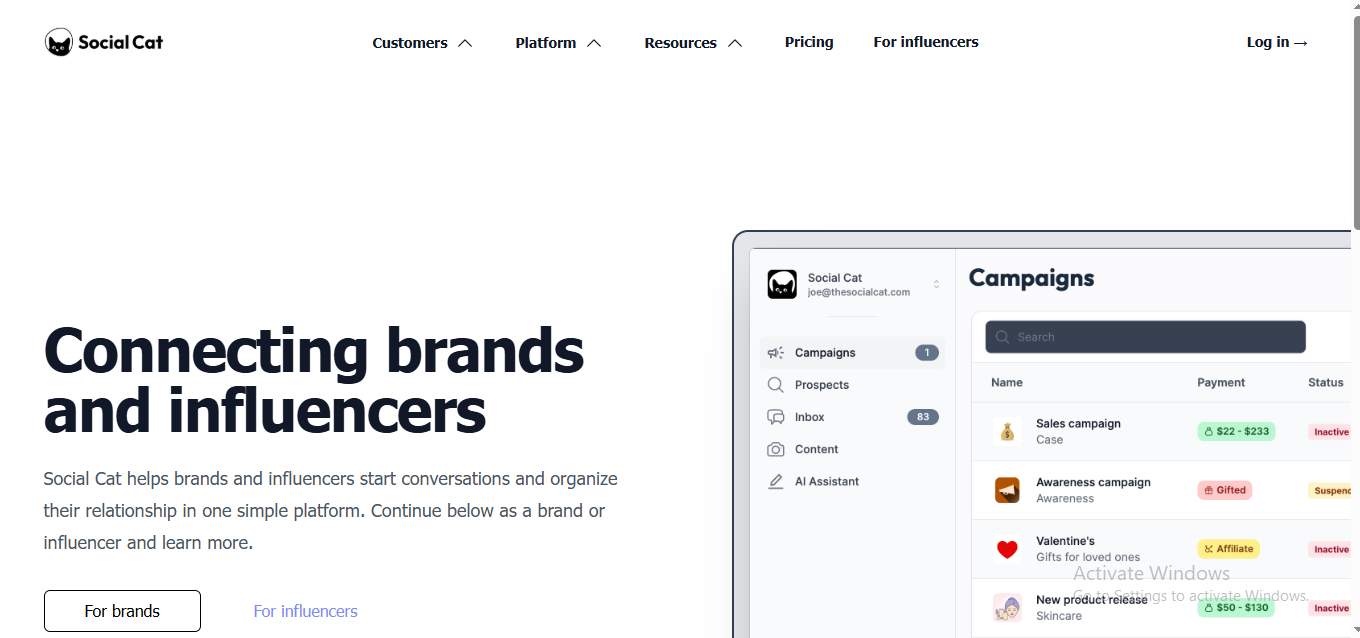
The Gen Z Darling That’s All About Collabs
Okay, I’m obsessed with the name. The Social Cat is basically like a Tinder for influencers and small brands. It’s UGC-focused, collab-driven, and super chill. You create a listing, and influencers apply to you. Yep—flip the game.
What I Liked:
- Influencers come to YOU? Love that.
- Built-in chat feature makes convos breezy
- Crazy affordable for startups and small businesses
What I Didn’t:
- Very UGC-focused—don’t expect celeb campaigns here
- Smaller database than big players
Pricing: Around £49/month last I checked—cheap and cheerful
Verdict: If you’re a small brand that lives on Insta or TikTok and you’re all about those bite-sized, real-deal content collabs, this is the one.
- Best LeadsGorilla Alternatives for 2025 - April 26, 2025
- Best Overloop Alternatives for 2025 - April 25, 2025
- Best Lead411 Alternatives for 2025 - April 25, 2025

